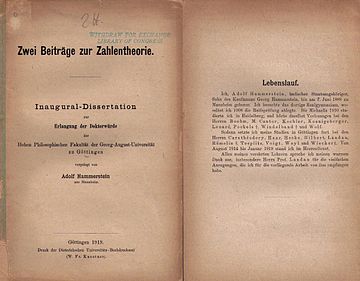Adolf Hammerstein
Adolf Hammerstein (born June 7, 1888 in Mannheim , † February 25, 1941 in Kiel ) was a German mathematician who worked in the field of analysis .
Life
Hammerstein studied in Heidelberg from 1908 and in Göttingen from 1910. There he wrote a doctoral thesis on number theory under the guidance of Edmund Landau in 1914 , but was unable to complete his doctorate due to the First World War . After he had been a soldier from 1914 to 1919, he received his doctorate at the Georg-August-Universität Göttingen with his thesis on number theory (the first part of the doctoral thesis uses the so-called Pfeiffer method ). After further studies in Tübingen and Berlin , he was a research assistant at the Friedrich-Wilhelms-Universität zu Berlin and after his habilitation in 1924 he taught there until 1935 (first as a private lecturer, then from 1928 as an associate professor); then he was a professor at the University of Kiel .
Hammerstein mainly provided results in the calculus of variations , the partial differential equations and in the theory of the nonlinear integral equations ( Hammerstein's integral equation ).
Hammerstein's integral equation is:
There is an area in the -dimensional space, the function , the core of the integral equation and the non-linear function are given, is the function sought.
Michael Golomb (1909–2008) was one of his students .
He was known as a rider.
Web links
- Short biography at DMV
- Hammerstein's integral equation (Gerd Fischer et al. (Ed.), A Century of Mathematics, Vieweg 1990)
Individual evidence
- ↑ Gerd Fischer u. a. (Ed.), A Century of Mathematics 1890-1990, Festschrift 100 Years DMV, Vieweg 1990, p. 283
| personal data | |
|---|---|
| SURNAME | Hammerstein, Adolf |
| BRIEF DESCRIPTION | German mathematician |
| DATE OF BIRTH | June 7, 1888 |
| PLACE OF BIRTH | Mannheim |
| DATE OF DEATH | February 25, 1941 |
| Place of death | Kiel |







